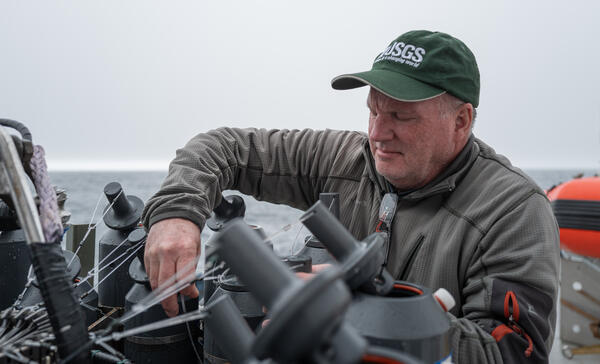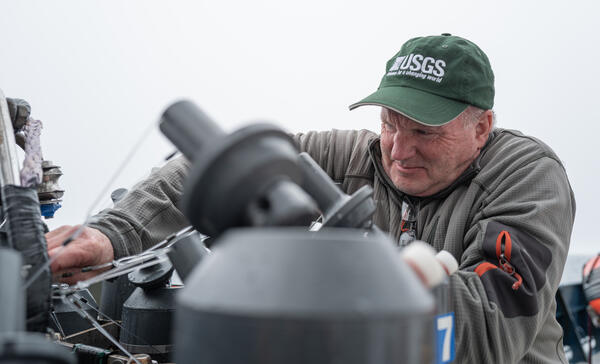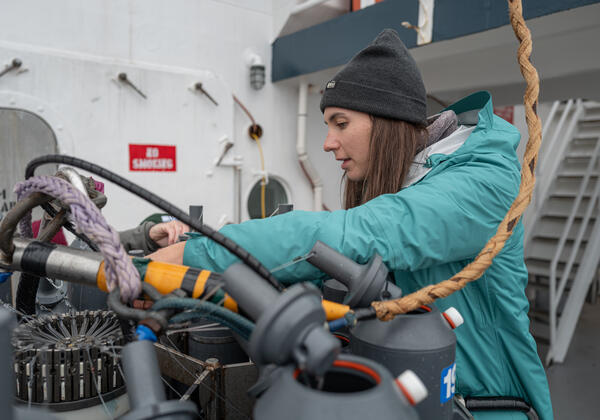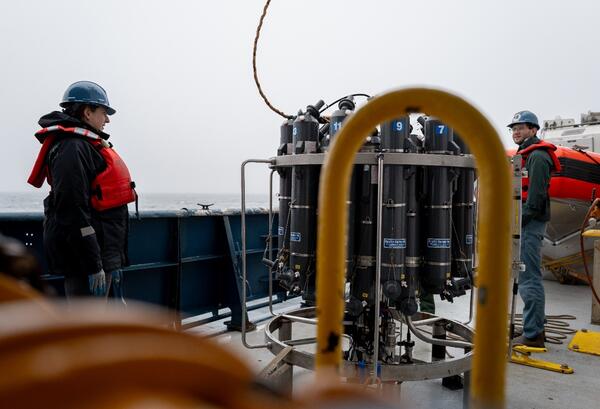A scientist on the Aleutian Arc Expedition sets Niskin bottles on the CTD
A scientist on the Aleutian Arc Expedition sets Niskin bottles on the CTDA scientist on the Aleutian Arc Expedition sets Niskin bottles on the CTD, Alaska

An official website of the United States government
Here's how you know
Official websites use .gov
A .gov website belongs to an official government organization in the United States.
Secure .gov websites use HTTPS
A lock () or https:// means you’ve safely connected to the .gov website. Share sensitive information only on official, secure websites.
Explore WARC's multimedia resources.

A scientist on the Aleutian Arc Expedition sets Niskin bottles on the CTD, Alaska
A scientist on the Aleutian Arc Expedition sets Niskin bottles on the CTD, Alaska

A scientist on the Aleutian Arc Expedition sets Niskin bottles on the CTD before it is deployed
A scientist on the Aleutian Arc Expedition sets Niskin bottles on the CTD before it is deployed
Three scientists prepare a CTD for deployment aboard the Aleutian Arc expedition, Alaska
Three scientists prepare a CTD for deployment aboard the Aleutian Arc expedition, Alaska

A scientist prepares the Niskin bottles on a CTD before deployment on the Aleutian Arc expedition
A scientist prepares the Niskin bottles on a CTD before deployment on the Aleutian Arc expedition

Dr. Maria Figueroa, Research Geologist at USGS Pacific Coastal and Marine Science Center, holding two splits from a mustone recovered from the seafloor.
Dr. Maria Figueroa, Research Geologist at USGS Pacific Coastal and Marine Science Center, holding two splits from a mustone recovered from the seafloor.

Two scientists prepare to deploy the CTD aboard the Aleutian Arc Expedition, Alaska
Two scientists prepare to deploy the CTD aboard the Aleutian Arc Expedition, Alaska
Stylized animation showing the shoreline of a wetland that is eroded by waves or currents eating away the sediment along the edge of the wetland. The displaced sediment is then deposited back onto the wetland platform by other waves. When this process happens continually, layers of displaced sediment build up over time, raising the surface of the wetland.
Stylized animation showing the shoreline of a wetland that is eroded by waves or currents eating away the sediment along the edge of the wetland. The displaced sediment is then deposited back onto the wetland platform by other waves. When this process happens continually, layers of displaced sediment build up over time, raising the surface of the wetland.
 title card for Florida Bonneted Bat Data Submission Workshop (Part 4 Acoustic Surveys)
title card for Florida Bonneted Bat Data Submission Workshop (Part 4 Acoustic Surveys)
Recording of the Florida Bonneted Bat Data Submission Workshop: Part 4 - Acoustic Surveys
This video describes how to prepare and submit acoustic data into the NABat portal.
Spreaker: Roxanne Pourshoushtari (USGS)
Presentation contributors and moderators: Laura D’Acunto (USGS) and Sandra Sneckenberger (FWS)
Recording of the Florida Bonneted Bat Data Submission Workshop: Part 4 - Acoustic Surveys
This video describes how to prepare and submit acoustic data into the NABat portal.
Spreaker: Roxanne Pourshoushtari (USGS)
Presentation contributors and moderators: Laura D’Acunto (USGS) and Sandra Sneckenberger (FWS)
 title card for recording of Florida Bonneted Bat Data Submission Workshop (Part 5 Uploading Acoustic Data)
title card for recording of Florida Bonneted Bat Data Submission Workshop (Part 5 Uploading Acoustic Data)
Recording of the Florida Bonneted Bat Data Submission Workshop: Part 5 - Uploading Acoustic Data
Speaker: Roxanne Pourshoushtari (USGS)
Presentation contributors and moderators: Laura D’Acunto (USGS) and Sandra Sneckenberger (FWS)
Recording of the Florida Bonneted Bat Data Submission Workshop: Part 5 - Uploading Acoustic Data
Speaker: Roxanne Pourshoushtari (USGS)
Presentation contributors and moderators: Laura D’Acunto (USGS) and Sandra Sneckenberger (FWS)
 title card for Florida Bonneted Bat Data Submission Workshop (Part 2 Creating an NABat Project and Species List)
title card for Florida Bonneted Bat Data Submission Workshop (Part 2 Creating an NABat Project and Species List)
Recording of the Florida Bonneted Bat Data Submission Workshop: Part 2 - Creating an NABat Project and Species List
Spreaker: Roxanne Pourshoushtari (USGS)
Presentation contributors and moderators: Laura D’Acunto (USGS) and Sandra Sneckenberger (FWS)
Recording of the Florida Bonneted Bat Data Submission Workshop: Part 2 - Creating an NABat Project and Species List
Spreaker: Roxanne Pourshoushtari (USGS)
Presentation contributors and moderators: Laura D’Acunto (USGS) and Sandra Sneckenberger (FWS)
 title card for Florida Bonneted Bat Data Submission Workshop (Part 6 Finish Submitting Project)
title card for Florida Bonneted Bat Data Submission Workshop (Part 6 Finish Submitting Project)
Recording of the Florida Bonneted Bat Data Submission Workshop: Part 6 - Finish Submitting Project
Speaker: Roxanne Pourshoushtari (USGS)
Presentation contributors and moderators: Laura D’Acunto (USGS) and Sandra Sneckenberger (FWS)
Recording of the Florida Bonneted Bat Data Submission Workshop: Part 6 - Finish Submitting Project
Speaker: Roxanne Pourshoushtari (USGS)
Presentation contributors and moderators: Laura D’Acunto (USGS) and Sandra Sneckenberger (FWS)
 Screenshot of a Microsoft Teams meeting with 6 people smiling on camera
Screenshot of a Microsoft Teams meeting with 6 people smiling on camera
Three USGS Centers held this virtual event on February 23, 2023 to showcase various science career paths within USGS: the Caribbean-Florida Water Science Center, St.
Three USGS Centers held this virtual event on February 23, 2023 to showcase various science career paths within USGS: the Caribbean-Florida Water Science Center, St.
Welcome to the USGS Ecosystems Mission Area Outstanding in the Field podcast series that tells stories about our science, our adventures, and our efforts to better understand fish and wildlife and the ecosystems that support them.
Welcome to the USGS Ecosystems Mission Area Outstanding in the Field podcast series that tells stories about our science, our adventures, and our efforts to better understand fish and wildlife and the ecosystems that support them.
In this episode of Outstanding in the Field, we take you to the swamps and coastal wetlands of Louisiana, the land of bayous and beignets and a state with one of the most dynamic coastlines in the United States. The wetlands that make up the Louisiana coast are vast and help protect important cultural and natural resources.
In this episode of Outstanding in the Field, we take you to the swamps and coastal wetlands of Louisiana, the land of bayous and beignets and a state with one of the most dynamic coastlines in the United States. The wetlands that make up the Louisiana coast are vast and help protect important cultural and natural resources.
The USGS Ecosystems Mission Area brings you Outstanding in the Field, a series of stories about our science, our adventures, and our efforts to better understand our fish and wildlife and the ecosystems that support them. In this episode we describe the USGS’s efforts to track frog populations in the southeast United States.
The USGS Ecosystems Mission Area brings you Outstanding in the Field, a series of stories about our science, our adventures, and our efforts to better understand our fish and wildlife and the ecosystems that support them. In this episode we describe the USGS’s efforts to track frog populations in the southeast United States.
Can you hear the difference between the non-native Cuban treefrog and two common Louisiana native treefrogs? Cuban treefrogs’ call is distinctive. Biologist Paul Moler of the Florida Fish and Wildlife Conservation Commission recorded them in South Florida. Credit: Paul Moler, used with permission.
Can you hear the difference between the non-native Cuban treefrog and two common Louisiana native treefrogs? Cuban treefrogs’ call is distinctive. Biologist Paul Moler of the Florida Fish and Wildlife Conservation Commission recorded them in South Florida. Credit: Paul Moler, used with permission.
Squirrel treefrogs are also native to Florida and Louisiana. Hear them calling from ditches, puddles and other ephemeral pools of water. Credit: Paul Moler, used with permission.
Squirrel treefrogs are also native to Florida and Louisiana. Hear them calling from ditches, puddles and other ephemeral pools of water. Credit: Paul Moler, used with permission.
Green treefrogs call from their favorite habitat, rivers and lakes. They’re native to Louisiana and Florida, where these were recorded. Credit: Paul Moler, used with permission.
Green treefrogs call from their favorite habitat, rivers and lakes. They’re native to Louisiana and Florida, where these were recorded. Credit: Paul Moler, used with permission.
